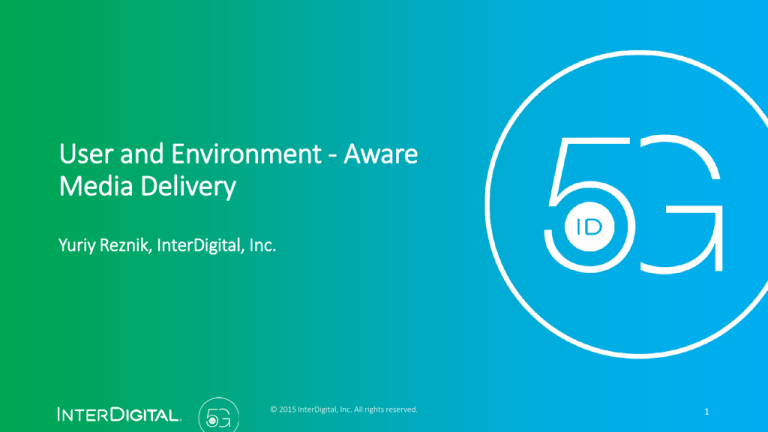
User and Environment - Aware
Media Delivery
Yuriy Reznik, InterDigital, Inc.
© 2015 InterDigital, Inc. All rights reserved.
1
Evolution of Video Technologies
Key Milestones:
THE PAST:
THE PRESENT:
THE FUTURE:
Invention of camera, still image
photography, color reproduction,
film, moving pictures
New delivery methods: TV, recordable media, digital
compressed formats, Internet streaming, mobile.
Recording & reproduction
systems making rendered
video undistinguishable
from reality.
Increasing degree of realism: immersive video, 3D
(holography, stereoscopic rendering, etc.)
Photography:
φῶς + γραφή =
drawing with light
1861
First
color
photo
1021
Camera
obscura,
Alhazen
CE
1820s-1830s
First photographs
1888
T. Edisson’s
Kinetoscope
Color TV
NTSC: 1941
SECAM: 1956
PAL:
1963
1930s
First
TVs
1800s
Key Themes/Directions:
1970s+
Cable, &
satellite
TV
1960s
First practical
holography
methods
1900s
First movies,
1995+
Internet streaming
Media
VHS: 1983
DVD: 2000
BD: 2006
2000s
Shift from physical
media to VoD and
Internet
2000s
Smartphones,
Mobile video
2000s
3D cinema
Video Resolutions
4K:
2012+
HDTV: 1981-2000s
SD :
1941-1980s
1900s
2000s
AR & VR systems
HDR / Brighter displays:
1000+nits: 2010+
400 nits: 2000s
200 nits: 1970-1990s
2000s
Picture credit: TriLite Technologies
Ultra realistic video
delivery systems
TIME
• Increasing degree of realism
-
Ultimate video/media reproduction = undistinguishable from reality
• Improving convenience of access
-
Anywhere, anytime, in any environment
© 2015 InterDigital, Inc. All rights reserved.
2
Why Environment Matters?
Cone
responses
Ambient light
Surround field
Rods & cones
Layers & processing stages in
primary visual cortex (V1)
LGNs
Display
Visual Cortex
Image
Display emitted +
reflected light
Retina
Optic nerve
Contrast Sensitivity Function (CSF):
- effects of changing brightness and field size:
Pixel domain
Optical domain
Processing
stages
Image
rendering
Mix with other
light sources
Variables /
processes
Display characteristics
(primary colors,
gamma, brightness,
contrast, display MTF)
Reflected ambient
Other light sources in
the surround field
Neural domain
Retinal image
formation
Cortical image
representation &
processing
Vergence
Retinal processing
Accommodation
LGN processing
Pupil diameter adaptation Processing at layers in V1,..V6
Eye optical MTF
Dorsal & ventral streams
Affected by environmental factors
© 2015 InterDigital, Inc. All rights reserved.
3
Targeting Different Viewing Environments
• Traditionally, video encodings are done without taking viewing environment into account
• But, what if:
• we obtain information about viewing environment at user’s end, and then
• apply a perceptual pre-processing step to retarget video to such an environment?
• This can be used for:
• Making videos look better (more natural/real) in a given reproduction environment and/or
• Improving compression – remove parts of visual content that are not visible
0%
Contrast
Lateral
inhibition
Visual
acuity
VISION
MODEL
Viewing
Parameters
CAMERA AND
SENSOR ANALYSIS
Camera
& Sensors
20%
Spatial Frequency [cycles per degree, cpd]
PRE-PROCESSOR
ENCODER
NETWORK
Ambient light
Distance
Video source
© 2015 InterDigital, Inc. All rights reserved.
4
Deployment Scenarios
Static (pre-processor)
Optimized encoder
Contribution
encoder
Mezzanine
Perceptual
PreProcessor
Broadcast
encoder
Optimized
stream
Server
Managed
network
Receiver
+ TV set
• Perceptual pre-processor is used to optimize delivery to typical reproduction settings in a living room.
• Geared towards IPTV/cable/broadcast deployments
Dynamic (pre-processor + adaptive streaming)
ABR
streaming
encoder
Server
Stream 1, 1080p
Customized 1080p
Streams
Stream 2, 720p
Perceptual
PreProcessor
Customized 720p
Streams
CDN
Streaming Client
Mobile
network
Additional logic in client
Analysis of
User detection &
viewing conditions activity classification
Decoding,
rendering
Bandwidth
estimator
Stream 3, 480p
Stream N
Manifest File
Stream selector
Manifest reader
• Perceptual pre-processor is used to generate additional streams, customized to different possible poses of a viewer (viewing distances where
device is held in hands, on lap, or placed on a stand), ambient light conditions, etc.
• Streaming client uses estimated viewing conditions as additional parameters for stream selection
• Geared towards ABR streaming deployments
© 2015 InterDigital, Inc. All rights reserved.
5
PerceptFXTM – Perceptual Pre-Processor from InterDigital
• Product of InterDigital Communications, Inc.
• Commercially available since Aug 2015
• Available as:
• File-based video processing tool
• Plugin for video post-production and encoding workflows
• SDK for integration with video encoding products
• Enables customization of encodings to several types
of reproduction settings:
• At home / TV viewing
• Viewing on mobile devices
•
Smartphones, 7”, 10” tablets, etc.
• BT.500 expert viewing environment, etc.
• Works with current codecs and formats
• H.264, HEVC, VP9
• SD, HD, Ultra-HD
• HDR (BT.2020, 10-16 bits)
• Can be used for:
• Reducing bitrates of HD or Ultra-HD encodings or
• Improving quality at same rates
© 2015 InterDigital, Inc. All rights reserved.
6
PerceptFXTM benefits – Ultra-HD use case
© 2015 InterDigital, Inc. All rights reserved.
7
Conclusions & Outlook
• Environment-aware / perceptual processing approach works
• It works well with today’s latest codecs and video formats (H.264, HEVC, HD, UHD)
• Future trends:
• Ultra-HD / HDR: higher resolutions, higher frame-rates, and bit depths – make video streams
more redundant, resulting in a higher potential for savings using environment-aware /
perceptual techniques.
• Mobile streaming: environment/viewing conditions change dynamically as user moves
• Dynamic tracking and adaptation to such changes is offering an additional gain potential
• Realizable by adding user/environment adaptation logic in DASH streaming clients
• 5G / ultra low-delay networks: may enable designs of real-time perceptual systems:
• Gaze-point tracking + perceptual adaptation (foveation) offers an enormous (2-4x) rate savings
potential compared to conventional systems.
• Head/eye tracking can also be used for dynamic changes of views/perspectives – enabling realistic
glasses-free 3D rendering on 2D displays.
© 2015 InterDigital, Inc. All rights reserved.
8
Questions?
Contact:
Yuriy A. Reznik
Yuriy.Reznik@InterDigital.com
© 2015 InterDigital, Inc. All rights reserved.
9



